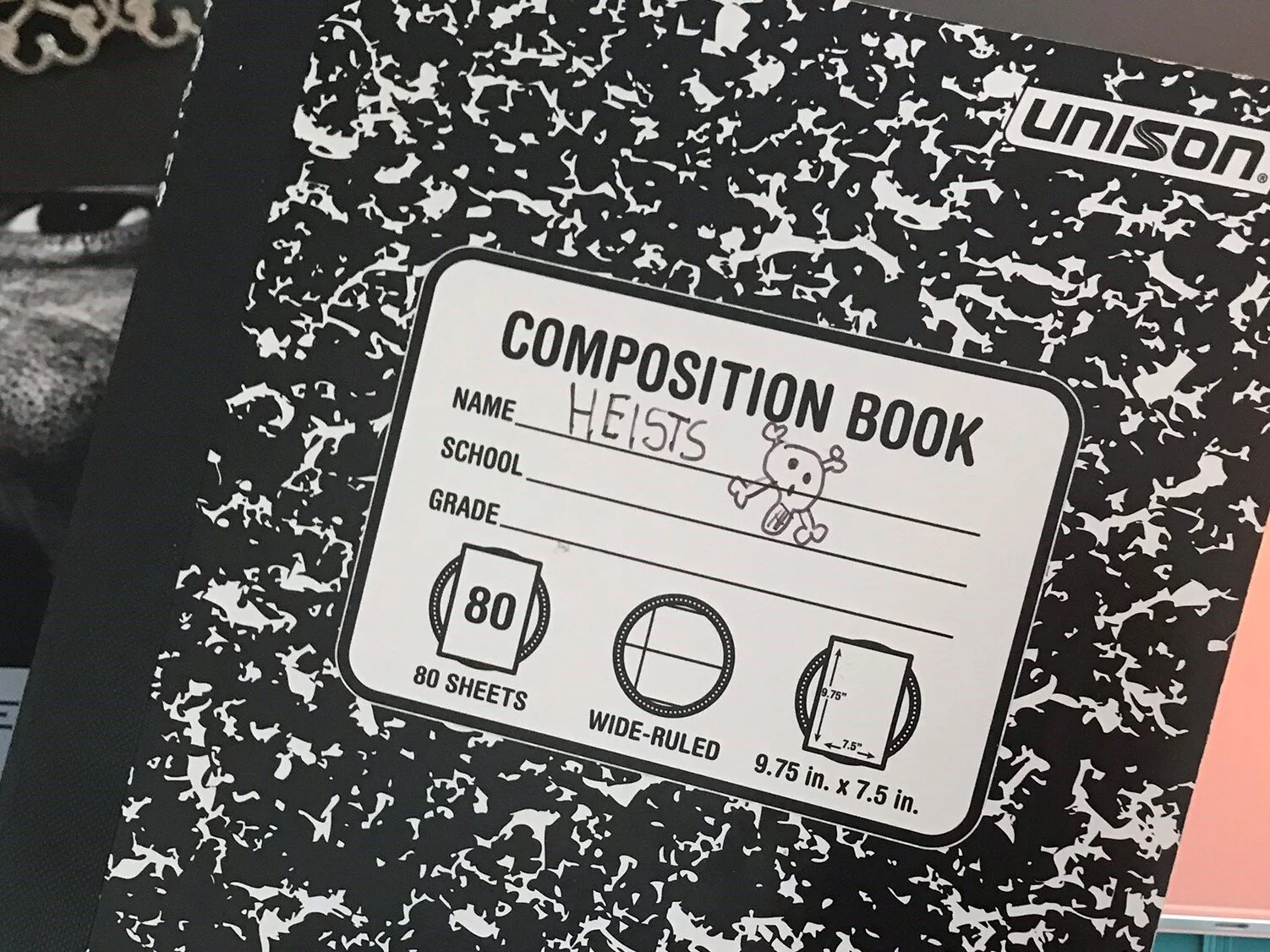41 movies later…resistance or research? Either way, these are the first 5 of the 16 conventions you need to nail if you want to make a great heist movie. Part 1 of 3.
This post is Part 1 of 3: Conventions 1-5 (see below)
Part 3 of 3: Conventions 10-16
And the full ‘Anatomy Of A Heist’ Series is here: charleskunken.com/season4
The List
This is the breakdown of the 41 films conducted during the research project, subjectively ranked best to worst then mapped to the 16 conventions. The green boxes indicate the conventions met for each one.
September 2018
I started watching heist films with the lights on, stopwatch and notebook in hand writing down everything that happened.
I’d been studying editor Shawn Coyne’s concept of ‘The Story Grid’ – a methodology he devised to answer specifically what makes stories ‘work’.
All good stories, Shawn teaches us, have general similarities in the form of plot points that meet our primal understanding of the world. And there is a checklist of nuances that are unique to each genre.
Methodology
Inspired by the fact that you could analyze stories (and attracted to the utter nerdom of it) I set out to make a check-list for my favorite genre: heists. (I was also stunned this didn’t exist on Google already.)
The remakes of The Thomas Crown Affair (1999) and Ocean’s 11 (2001) were my go to faves, so I started by re-watching those. They became the spine from which I would judge all other heist movies against. It was a pain in the arse writing down every minute of a movie and entering it into a spreadsheet so the project landed squarely on the back burner. But in the back of my mind I couldn’t escape the idea of what I would be able to do once I had the information. Every other month or so I’d get enough inspiration to pull out the ‘ole notebook and document another heist film.
By November 2019 I had recorded minute-by-minute synopses on 7 heists in total[1]. I was developing a pretty good idea of the common trends and had a draft of my checklist in place. For all intents and purposes the training model was complete. Then we had a kid.
One of the biggest surprises of becoming a parent was realizing that paternity leave was actually the perfect opportunity to put my model to the test. I now had a completely unbiased partner with no prior knowledge of how the model was built. A perfect laboratory environment. Over the next month of nighttime feedings Lila and I would watch 34 heist movies together and plot them all against the checklist.
And sure enough, it worked! As we punched films into the model the ones we enjoyed the most were also hitting the most criteria. (Lila’s fave = The Great Muppet Caper)
The Checklist
There ended up being 16 criteria in our model, what Shawn Coyne would dub as ‘conventions’ and/or ‘obligatory scenes’ in his Story Grid lexicon.
Today we’ll look at the first five.
So without further ado, this is what your movie needs if you want to make a great heist film:
1. A Story About A Single Score
A proper heist film is a story about the preparation and execution of a single big score.
They are stories all about how our heroes steal something, not why (a fact that most bad heist movies miss).
This means the target of the heist needs to be established right out of the gate. Within the first 4 minutes of Ocean’s 11 (2001) Danny Ocean (George Clooney) eyes a newspaper article with casino magnate Terry Benedict. The first sequence of The Thomas Crown Affair (1999) has Pierce Brosnan (Crown) eating breakfast in front of the Monet that he is going to take.
On the other hand in Dead President’s (1995), a movie that didn’t cut it as a heist, there isn’t even mention of the armored truck until minute 73. This story was wrongly advertised. It’s really some sort of coming-of-age tale.
2. The Perpetrator Is The Hero
Crime stories are about cops, heists are about thieves. The protagonist must be the one pulling off the job.
Take Point Break (1991) for instance. While the string of robberies seems ‘heisty’ our hero is Keanu Reeves, FBI.
This ‘wet western’ is definitely a cult classic but it’s technically not a heist. It’s a ‘buddy love’[2] with an external genre of crime.
Cool masks though, those dead presidents.
3. The Hero Already Wants To Steal Things
Remember how we said it’s about the ‘how’ and not the ‘why’?
Trying to quickly jam in the whole backstory of why our hero goes from civilian to thief at the beginning of the film doesn’t work. It often comes out cheesy and leads to a caper (meaning, the job is run by a group of amateurs).
The character arc demonstrating the fall towards a life of crime is a separate story altogether. It requires a movie full of its own conventions and obligatory scenes in order to be sympathetic. (See masterpieces ‘Breaking Bad’ season 1 or more recently ‘Joker’).
The Killing (1956) and the Ocean’s 11 original (1966) are two examples that spend too much time showing us what drives the team members to participate in their first ever crime.
I think it can be clever for heist films to reveal the motivation behind the job as the movie plays out but our heroes should come out of the gates swinging, ok with stealing, planning to steal. Don’t start a movie by trying to give us a whole shifting of their moral compass.
We’re just here to see a score.
4. The Heist Must Be A Success
We want victory for our heroes. Justice is for villains.
When the arc of a story has created characters that we have grown to love and made them our heroes then it is a cathartic let down to see them fail.
Remember from post #1 in this series (‘Why You Love Heist Movies…’) - the purpose of heist stories are for master thieves to show us how they play outside the system and win.
The genre is not meant to be a public service announcement.[3] Besides, the heroes always steal from people who deserve it anyway. Or at least wouldn’t miss it (we’ll cover that in convention #15).
5. The Hero Gets The Want AND The Need
In the classic rules of drama in the end of a story the hero must sacrifice ‘The Thing They Want’ in order to gain ‘The Thing They Need’.
For example in Titanic (1997) Rose loses Leo to the icy Atlantic but is then emboldened to finally escape the shackles of society imposed by her mother and fiancé by hiding from them on the rescue ship. I’m tearing up just thinking about it.
But in a heist the sacrifice is a fake.
In the last scene of The Thomas Crown Affair (the 1999 one) after Pierce Brosnan has gotten away with the crime, Rene Russo – his investigator and love interest - is flying home. Crown is free but solo and Rene appears heart broken – she sacrificed their love affair in lieu of doing her job.
But just before the movie ends Crown jumps out from behind the next seat! He’s on the plane! They start making out as the screen fades to black and we can only surmise that they will spend the rest of their days making sweet love somewhere on an exotic beach. Now that’s how you end a heist.
Master thieves get the money AND the girl.
--
Tune in next week as we cover conventions 6 through 10…
Part 3 of 3: Conventions 10-16 (coming soon)
[1] Thomas Crown Affair (1999), Ocean's 11 (2001), The Score (2001), ‘The Italian Job’ (2003), Ocean's 12 (2004), Usual Suspects (1995), ‘Dead Presidents’ (1995)
[2] ‘Buddy Love’ is a genre coined by screenwriter Blake Snyder. See his book, ‘Save The Cat’: https://en.wikipedia.org/wiki/Blake_Snyder#Save_the_Cat!
[3] This problem of the heroes losing was especially prevalent in the older films of the 1950’s and 60’s where the demise of the thieves always seemed to come at the last minute and was often due to some random occurrence unrelated to the story at all. (see force majeure, deus ex machina).
This historical trend made us curious so we investigated it and will be laying out all our findings in a ‘History Of The Heist’ post coming later in this series.
Have some thoughts? Feel free to drop a comment or hit me up: charlie@charleskunken.com













The Skytalkers podcast recently aired an episode in which they ran Solo: A Star Wars Story (2018) through the heist tracker - the one we made together during paternity leave ;) charleskunken.com/blog/the-anatomy-of-a-heist-the-16-conventions-part-1-of-3).
Star Wars plus heists? Yea…we just had to take this inspiration from our friends at Skytalkers and contribute our own ‘Milk in The Matrix version of ‘is Solo a heist film?’